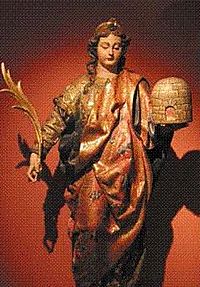Eulalia of Mérida facts for kids
Quick facts for kids SaintEulalia of Mérida |
|
|---|---|

Image of Santa Eulalia in Merida Cathedral
|
|
| Virgin martyr | |
| Born | c. AD 290 Mérida, Spain |
| Died | c. AD 304 Mérida |
| Venerated in | Catholic Church, Eastern Orthodox Church |
| Canonized | 304 |
| Major shrine | Cathedral of San Salvador |
| Feast | 10 December |
| Attributes | cross, stake, and dove |
| Patronage | Mérida, Spain; Oviedo, Spain; runaways; torture victims; widows; inclement weather |
Eulalia of Mérida was a brave young Christian girl who lived a long time ago, around 290 AD. She died in the city of Mérida, Spain, in the year 304. She became a martyr during a time when Christians were being persecuted by the Roman Emperor Diocletian. Some people think she might have died a bit earlier, during the time of Emperor Trajan Decius. Her story is very similar to another saint, Saint Eulalia of Barcelona. People sometimes wonder if they were the same person. For a long time, Saint Eulalia was seen as a special protector for Christian soldiers in Spain.
Eulalia's Story
Eulalia was a very religious Christian girl, only about 12 to 14 years old. In 304 AD, her mother sent her to the countryside to keep her safe. This was because everyone in the Roman Empire had to say they believed in the Roman gods.
But Eulalia was very determined. She ran away to the city of Emerita (now Mérida) and went to the governor's court. There, she bravely announced that she was a Christian. She also spoke against the Roman gods and the Emperor Maximian. She even challenged the authorities to make her a martyr.
The judge tried to convince her with kind words and gifts, but Eulalia refused. A poet from the 400s, named Prudentius, wrote about her. He said Eulalia declared:
After this, soldiers stripped Eulalia and tortured her with hooks and torches. She was then burned at a stake. She died from breathing in too much smoke. Even while she was being tortured, she kept challenging her tormentors.
As she passed away, a dove flew out of her mouth. This scared the soldiers away. Then, a wonderful thing happened: a miraculous snow fell and covered her body. The pure white snow showed that she was a saint.
Soon after, a special shrine was built over Eulalia's tomb. By the year 350, many Christians already honored her. Prudentius' poem made her even more famous, and parts of her body (called relics) were sent to different places across Spain.
Around 560, a bishop named Fidelis rebuilt a large church in her honor. Her shrine became the most popular in Spain during the time of the Visigoths. Around 780, her body was moved to the city of Oviedo by King Silo. Today, her body rests in a silver coffin that was given by King Alfonso VI in 1075. In 1639, she was made the patron saint of Oviedo. Her story is also told in a book called Martyrs Mirror from 1660.
Saint Julia of Mérida
Saint Julia of Mérida is often mentioned with Eulalia. They are sometimes honored together. Julia is also said to have been a young girl who died as a martyr in Mérida in 304. She was killed during the same persecution by Emperor Diocletian. Her special day is also celebrated on December 10, just like Eulalia's.
See also
 In Spanish: Eulalia de Mérida para niños
In Spanish: Eulalia de Mérida para niños
- Saint Eulalia of Mérida, patron saint archive
- Sequence of Saint Eulalia – A French story about her life from 880

